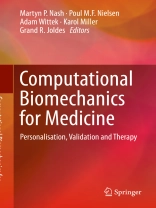This book contains contributions from computational biomechanics specialists who present and exchange opinions on the opportunities for applying their techniques to computer-integrated medicine, including computer-aided surgery and diagnostic systems. Computational Biomechanics for Medicine collects peer-reviewed chapters from the annual Computational Biomechanics for Medicine Workshop, in conjunction with the Medical Image Computing and Computer Assisted Intervention [MICCAI] Society conference. The works are dedicated to research in the field of methods and applications of computational biomechanics to medical image analysis, image-guided surgery, surgical simulation, surgical intervention planning, disease diagnosis and prognosis, analysis of injury mechanisms, implant and prosthesis design, artificial organ design, and medical robotics. These chapters will appeal to a wide range of researchers and students within the fields of engineering and medicine, as well as those working in computational science.
Tabla de materias
Chapter1. Biomechanical simulation of vaginal childbirth: the colors of the pelvic floor muscles.- Chapter2. Patient-specific modeling of pelvic system from MRI for numerical simulation: validation using a physical model.- Chapter3. Numerical analysis of the risk of pelvis injuries under multidirectional impact load.- Chapter4. Parametric study of lumbar belts in the case of low back pain: effect of patients’ specific characteristics.- Chapter5. Quantitative validation of MRI-based motion estimation for brain impact biomechanics.- Chapter6. Meshless method for simulation of needle insertion into soft tissues: preliminary results.- Chapter7. A biomechanical study on the use of curved drilling technique for treatment of osteonecrosis of femoral head.- Chapter8. A hybrid 0D-1D model for cerebral circulation and cerebral arteries.- Chapter9. Removing drift from carotid arterial pulse waveforms: a comparison of motion correction and high-pass filtering. Chapter10. Rapid blood flow computation on digital subtraction angiography: preliminary results. Chapter11. Muscle excitation estimation in biomechanical simulation using NAF reinforcement learning.












